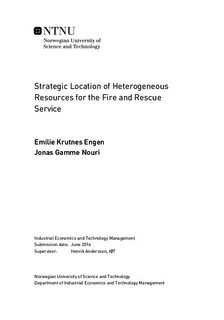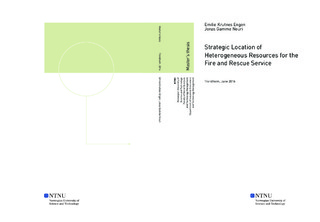| dc.description.abstract | The fire and rescue service (FRS) in Norway is responsible for responding to a number of different emergency calls. Keeping an adequate level of preparedness is essential in order to respond quickly and efficiently to emergency fire and rescue calls. This requires extensive planning at the strategic, tactical, and operational levels. Operational research and optimization models are important support tools for decision makers in emergency response planning (ERP). However the previous research on FRS is limited, compared to emergency medical service (EMS), which has been at the interest of operational researchers since the 1960's.
When considering the FRS, the preservation of life and property is the main objective. The problem studied in this report is the Maximum Preservation Location Problem for Heterogeneous Accidents and Response Units (MPLP-HAR). It aims at finding the optimal location for the FRS resources in an area that gives the highest level of preparedness, in order to respond to a demand for heterogeneous accidents. To solve the problem, an integer programming model has been developed. The objective function uses a preservation function that captures the distinct ability to preserve life and property in the event of an emergency. Hence, the preservation function reflects the level of preparedness.
The model distinguishes between first and total response time. In this case, these response times refer to the time it takes for the FRS to initiate and fully provide emergency relief at the accident site, respectively. Response units respond to different accident types with different resource requirements. Demand for a given accident type is determined based on historical call data. The results show that the model can be used as a support tool for various types of location decisions at the strategic and tactical levels.
The computational study includes both a technical and an economical part. The technical study determines the appropriate formulation and solution approach for the problem. The economical studies is performed on the region of Oslo, in corporation with Oslo Brann- og Redningstjeneste (BRE). After validation, the model is able to provide quantifiable measures of preparedness in the region and evaluate the current operational state. Furthermore, the MPLP-HAR is used to investigate a number of alternative resource locations and operational structures that could improve the level of preparedness. The MPLP-HAR is a strategic and tactical location decision support tool and its applicability increases with data accuracy. | |

